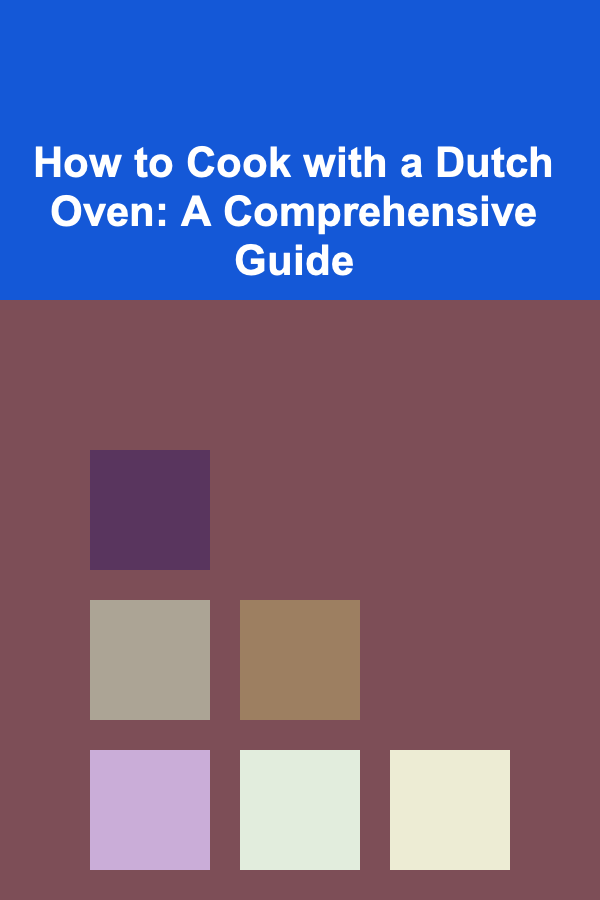
How to Cook with a Dutch Oven: A Comprehensive Guide
ebook include PDF & Audio bundle (Micro Guide)
$12.99$6.99
Limited Time Offer! Order within the next:

Introduction: The Versatile Dutch Oven
The Dutch oven, a heavy-walled cooking pot with a tight-fitting lid, is a kitchen workhorse beloved by cooks for its versatility and ability to deliver exceptional results. From slow-braised meats and hearty stews to crusty loaves of bread and even decadent desserts, the Dutch oven's even heat distribution and excellent heat retention make it a perfect tool for a wide range of culinary endeavors. Whether you're a seasoned chef or a home cook just starting out, mastering the Dutch oven opens up a world of delicious possibilities.
This comprehensive guide will explore the various aspects of cooking with a Dutch oven, covering everything from selecting the right pot to mastering essential techniques and exploring exciting recipes. We'll delve into the history of the Dutch oven, discuss the different types available, provide tips for seasoning and maintaining your pot, and offer step-by-step instructions for a variety of dishes that showcase its unique capabilities. Prepare to embark on a culinary journey that will transform the way you cook and experience food.
A Brief History of the Dutch Oven
The origins of the Dutch oven can be traced back to the 17th century in the Netherlands, where they were made using sand casting, a technique that allowed for the creation of durable and relatively inexpensive cookware. These early Dutch ovens were quickly adopted by European colonists in North America, where they became indispensable tools for cooking over open fires and hearths. Their durability and versatility made them ideal for cooking in the challenging conditions of the frontier.
Over time, Dutch ovens evolved and adapted to different needs and cooking styles. Early models often had legs, allowing them to sit directly over hot coals, while later versions were designed for stovetop use. Regardless of their specific design, Dutch ovens have remained a constant presence in kitchens and campsites around the world, cherished for their ability to create flavorful and satisfying meals.
Choosing the Right Dutch Oven
Selecting the right Dutch oven is crucial for achieving the best results in your cooking. Several factors should be considered, including material, size, shape, and features.
Material: Cast Iron vs. Enameled Cast Iron
The two primary materials for Dutch ovens are cast iron and enameled cast iron.
- Cast Iron: Traditional cast iron Dutch ovens are known for their exceptional heat retention and ability to withstand high temperatures. They are incredibly durable and can last for generations with proper care. However, they require regular seasoning to prevent rusting and can react with acidic foods, potentially altering their flavor.
- Enameled Cast Iron: Enameled cast iron Dutch ovens offer the benefits of cast iron with the added convenience of a non-reactive surface. The enamel coating prevents rusting and eliminates the need for seasoning. They are also easier to clean and come in a variety of colors. However, enameled cast iron can be more expensive than traditional cast iron and is susceptible to chipping if dropped or overheated.
Size and Shape
Dutch ovens come in a variety of sizes, typically ranging from 2 quarts to 13 quarts or more. The ideal size will depend on the types of dishes you plan to cook and the number of people you typically cook for.
- Small (2-4 quarts): Suitable for single servings, side dishes, and small batches of sauces or soups.
- Medium (5-7 quarts): A versatile size that can accommodate most recipes for a family of four to six.
- Large (8 quarts and up): Ideal for large gatherings, roasting whole chickens or turkeys, and making large batches of stews or chilis.
The shape of the Dutch oven also matters. Round Dutch ovens are generally better for braising and roasting, while oval Dutch ovens are ideal for cooking larger cuts of meat or whole birds. Consider the types of recipes you plan to make most frequently when choosing a shape.
Features to Consider
- Lid: A tight-fitting lid is essential for trapping moisture and creating a self-basting effect. Look for a lid that fits snugly and has condensation rings on the underside to help distribute moisture evenly.
- Handles: Sturdy side handles are important for safely lifting and moving the Dutch oven, especially when it is full. Some Dutch ovens also have a bail handle for hanging over a campfire.
- Oven-Safe Knob: Ensure the lid knob is oven-safe to the temperatures you'll be using. Many plastic knobs have a limited oven-safe temperature and may need to be replaced with a metal one.
Recommendations
For beginners, a 6-quart enameled cast iron Dutch oven is a great starting point. It's versatile enough to handle a variety of recipes and relatively easy to care for. Brands like Le Creuset, Staub, and Lodge offer high-quality Dutch ovens that are built to last.
Seasoning and Maintaining Your Dutch Oven
Proper seasoning and maintenance are essential for ensuring the longevity and performance of your Dutch oven, particularly if it's made of bare cast iron.
Seasoning a Cast Iron Dutch Oven
Seasoning creates a layer of polymerized oil that protects the cast iron from rusting and provides a non-stick surface.
- Clean the Dutch Oven: Wash the Dutch oven thoroughly with hot, soapy water and a scrub brush. Rinse well and dry completely.
- Apply a Thin Layer of Oil: Use a clean cloth or paper towel to apply a thin, even layer of cooking oil (such as vegetable oil, canola oil, or flaxseed oil) to the entire surface of the Dutch oven, inside and out. Be sure to wipe off any excess oil. The goal is a very thin layer. Too much oil will lead to a sticky, gummy surface.
- Bake the Dutch Oven: Place the Dutch oven upside down on the middle rack of your oven. Place a baking sheet on the rack below to catch any drips. Bake at 450°F (232°C) for one hour.
- Cool and Repeat: Turn off the oven and let the Dutch oven cool completely inside. Repeat steps 2 and 3 several times to build up a strong seasoning. Three to four rounds are usually sufficient.
Maintaining a Cast Iron Dutch Oven
- Clean After Each Use: Wash the Dutch oven with hot water and a scrub brush. Avoid using harsh detergents or abrasive cleaners, as they can damage the seasoning. Dry the Dutch oven thoroughly.
- Re-Season as Needed: If you notice any rust or the seasoning starts to wear away, re-season the Dutch oven as described above.
- Oil After Cleaning: After washing and drying, apply a thin layer of oil to the inside of the Dutch oven to help maintain the seasoning.
- Store Properly: Store the Dutch oven in a dry place with the lid slightly ajar to allow air to circulate. This will help prevent rust from forming. Some people place a paper towel inside to absorb moisture.
Caring for Enameled Cast Iron Dutch Ovens
Enameled cast iron Dutch ovens are generally easier to care for than bare cast iron, but there are still a few things to keep in mind.
- Avoid Thermal Shock: Avoid exposing the enameled surface to sudden temperature changes, such as placing a hot Dutch oven in cold water. This can cause the enamel to crack.
- Use Non-Abrasive Cleaners: Use mild dish soap and a soft sponge or cloth to clean the enameled surface. Avoid using abrasive cleaners or scrub brushes, as they can scratch the enamel.
- Avoid Metal Utensils: Use wooden or silicone utensils to stir and serve food from the Dutch oven to prevent scratching the enamel.
- Dry Thoroughly: Dry the Dutch oven thoroughly after washing to prevent rust from forming on any exposed cast iron.
Essential Techniques for Dutch Oven Cooking
Mastering a few essential techniques will unlock the full potential of your Dutch oven.
Braising
Braising is a cooking method that involves searing meat or vegetables at high heat, then simmering them in liquid for an extended period of time. The Dutch oven's excellent heat retention and tight-fitting lid make it perfect for braising, as it allows the food to cook evenly and retain moisture.
- Sear the Meat: Heat a small amount of oil in the Dutch oven over medium-high heat. Season the meat with salt and pepper, then sear it on all sides until browned. This creates a flavorful crust that will enhance the flavor of the dish.
- Sauté Vegetables: Remove the meat from the Dutch oven and set aside. Add chopped vegetables, such as onions, carrots, and celery, to the Dutch oven and sauté until softened.
- Deglaze the Pot: Pour in a liquid, such as wine, broth, or beer, and scrape up any browned bits from the bottom of the pot. This will add depth of flavor to the sauce.
- Return the Meat: Return the meat to the Dutch oven and add enough liquid to almost cover it.
- Simmer: Bring the liquid to a simmer, then cover the Dutch oven and transfer it to the oven. Cook at a low temperature (around 325°F/163°C) for several hours, or until the meat is tender.
Roasting
The Dutch oven can also be used for roasting meats, poultry, and vegetables. Its even heat distribution ensures that the food cooks evenly and develops a beautiful golden-brown crust.
- Prepare the Meat or Vegetables: Season the meat or vegetables with salt, pepper, and any other desired spices or herbs.
- Sear (Optional): For meats, searing before roasting can enhance the flavor and create a crispy crust. Follow the searing instructions above.
- Place in Dutch Oven: Place the meat or vegetables in the Dutch oven. You can add a rack to the bottom of the pot to elevate the food and prevent it from sitting in its own juices.
- Roast in the Oven: Cover the Dutch oven and roast in the oven at the desired temperature. The roasting time will depend on the size and type of food.
- Check for Doneness: Use a meat thermometer to check the internal temperature of the meat. Vegetables are done when they are tender and slightly caramelized.
Baking Bread
The Dutch oven is a fantastic tool for baking crusty, artisan-style bread. Its ability to trap steam creates a moist environment that allows the bread to rise fully and develop a crispy crust.
- Preheat the Dutch Oven: Preheat the Dutch oven in the oven at a high temperature (around 450-500°F/232-260°C) for at least 30 minutes. This ensures that the Dutch oven is hot enough to create a good crust.
- Prepare the Dough: Prepare your bread dough according to your favorite recipe.
- Place Dough in Dutch Oven: Carefully remove the Dutch oven from the oven and place the dough inside. You can use parchment paper to line the Dutch oven to prevent the bread from sticking.
- Bake Covered: Cover the Dutch oven and bake for a specified amount of time.
- Bake Uncovered: Remove the lid and continue baking until the bread is golden brown and the internal temperature reaches the desired level.
Deep Frying
A Dutch oven is an excellent vessel for deep frying. The heavy cast iron distributes heat evenly, preventing hot spots and maintaining a consistent oil temperature. The deep sides also help to contain splattering oil, making for a safer and less messy experience.
- Choose the Right Oil: Select an oil with a high smoke point, such as peanut oil, canola oil, or vegetable oil.
- Heat the Oil: Pour enough oil into the Dutch oven to reach a depth of at least 3 inches. Heat the oil over medium heat until it reaches the desired temperature (usually between 325°F and 375°F). Use a deep-fry thermometer to monitor the temperature.
- Prepare the Food: Prepare the food to be fried. This might involve battering, dredging in flour, or simply seasoning.
- Fry in Batches: Carefully lower the food into the hot oil in batches, being careful not to overcrowd the Dutch oven. Overcrowding will lower the oil temperature and result in soggy food.
- Cook Until Golden Brown: Cook the food until it is golden brown and cooked through. Use a slotted spoon or tongs to remove the food from the oil and place it on a wire rack to drain.
Dutch Oven Recipes to Get You Started
Classic Dutch Oven Beef Stew
Ingredients:
- 2 lbs beef stew meat, cut into 1-inch cubes
- 2 tbsp olive oil
- 1 large onion, chopped
- 2 carrots, peeled and chopped
- 2 celery stalks, chopped
- 4 cloves garlic, minced
- 1 tsp dried thyme
- 1/2 tsp dried rosemary
- 1 bay leaf
- 1/4 cup all-purpose flour
- 4 cups beef broth
- 1 cup red wine (optional)
- 1 lb potatoes, peeled and cubed
- 1 cup frozen peas
- Salt and pepper to taste
Instructions:
- Preheat oven to 325°F (163°C).
- Season beef with salt and pepper.
- Heat olive oil in the Dutch oven over medium-high heat. Sear beef on all sides until browned, then remove and set aside.
- Add onion, carrots, and celery to the Dutch oven and sauté until softened. Add garlic, thyme, rosemary, and bay leaf and cook for 1 minute more.
- Sprinkle flour over the vegetables and cook for 1 minute, stirring constantly.
- Gradually whisk in beef broth and red wine (if using), scraping up any browned bits from the bottom of the pot.
- Return beef to the Dutch oven. Add potatoes.
- Bring to a simmer, then cover and transfer to the oven. Cook for 2-3 hours, or until beef is tender.
- Stir in frozen peas during the last 15 minutes of cooking.
- Remove bay leaf before serving. Season with salt and pepper to taste.
No-Knead Dutch Oven Bread
Ingredients:
- 3 cups all-purpose flour
- 1 1/2 tsp salt
- 1/2 tsp instant yeast
- 1 5/8 cups lukewarm water
Instructions:
- In a large bowl, combine flour, salt, and yeast.
- Add water and stir until just combined. The dough will be shaggy and sticky.
- Cover the bowl with plastic wrap and let rise at room temperature for 12-18 hours.
- After rising, gently turn the dough out onto a lightly floured surface. Shape into a round.
- Place the dough on a piece of parchment paper.
- Preheat Dutch oven (with lid) in the oven at 450°F (232°C) for 30 minutes.
- Carefully remove the hot Dutch oven from the oven.
- Using the parchment paper as handles, gently lower the dough into the Dutch oven.
- Cover and bake for 30 minutes.
- Remove the lid and bake for another 15-20 minutes, or until the bread is golden brown.
- Let cool completely before slicing and serving.
Dutch Oven Chicken and Dumplings
Ingredients:
- 1 whole chicken (about 3-4 pounds)
- 1 tablespoon olive oil
- 1 large onion, chopped
- 2 carrots, peeled and chopped
- 2 celery stalks, chopped
- 4 cloves garlic, minced
- 8 cups chicken broth
- 1 teaspoon dried thyme
- 1/2 teaspoon dried rosemary
- 1 bay leaf
- Salt and pepper to taste
- For the Dumplings:
- 1 1/2 cups all-purpose flour
- 2 teaspoons baking powder
- 1/2 teaspoon salt
- 3 tablespoons cold butter, cut into small pieces
- 3/4 cup milk
Instructions:
- Prepare the Chicken: Rinse the chicken and pat it dry. Season generously with salt and pepper.
- Sear the Chicken (Optional): Heat olive oil in the Dutch oven over medium-high heat. Sear the chicken on all sides until lightly browned. Remove the chicken from the Dutch oven and set aside.
- Sauté Vegetables: Add onion, carrots, and celery to the Dutch oven and sauté until softened. Add garlic, thyme, rosemary, and bay leaf and cook for 1 minute more.
- Add Broth and Chicken: Pour in the chicken broth. Return the chicken to the Dutch oven. Make sure the chicken is mostly submerged in the broth.
- Simmer: Bring the broth to a simmer, then reduce heat to low, cover, and simmer for about 1 1/2 to 2 hours, or until the chicken is cooked through and tender. The internal temperature of the chicken should reach 165°F (74°C).
- Remove Chicken and Shred: Carefully remove the chicken from the Dutch oven and set aside to cool slightly. Once cool enough to handle, shred the chicken meat, discarding the skin and bones.
- Prepare the Dumplings: While the chicken is cooling, prepare the dumplings. In a medium bowl, whisk together the flour, baking powder, and salt. Cut in the cold butter using a pastry blender or your fingers until the mixture resembles coarse crumbs. Gradually stir in the milk until just combined. Do not overmix.
- Add Shredded Chicken and Dumplings: Return the shredded chicken to the Dutch oven with the broth. Drop spoonfuls of dumpling dough onto the simmering broth.
- Cook Dumplings: Cover the Dutch oven and simmer for about 15-20 minutes, or until the dumplings are cooked through and fluffy.
- Serve: Remove the bay leaf before serving. Season with additional salt and pepper to taste.
Tips and Tricks for Successful Dutch Oven Cooking
- Preheating is Key: Always preheat your Dutch oven, especially when baking bread or roasting.
- Low and Slow: Dutch ovens excel at slow cooking. Use low temperatures and long cooking times for tender and flavorful results.
- Don't Overcrowd: When braising or stewing, avoid overcrowding the Dutch oven. Cook in batches if necessary to ensure even browning and cooking.
- Use the Right Utensils: Use wooden or silicone utensils to avoid scratching the surface of the Dutch oven.
- Experiment with Different Recipes: Don't be afraid to experiment with different recipes and cooking techniques. The Dutch oven is a versatile tool that can be used to create a wide range of dishes.
- Proper Storage: Ensure your Dutch oven is completely dry before storing it. Leaving moisture inside can lead to rust. Store with the lid slightly ajar or place a paper towel inside to absorb any remaining moisture.
- Campfire Cooking: Dutch ovens are fantastic for campfire cooking. Use charcoal briquettes or hot coals to provide even heat. Distribute coals evenly under the Dutch oven and on top of the lid.
- Lid Lifter: If using a Dutch oven over a campfire, invest in a lid lifter. This will allow you to safely remove the hot lid without burning yourself.
- Don't be Afraid of the Heat: Dutch ovens are built to withstand high temperatures. Don't be afraid to crank up the heat for searing or baking.
- Explore Dutch Oven Communities: Join online forums or local cooking groups dedicated to Dutch oven cooking. Share recipes, tips, and experiences with other enthusiasts.
Conclusion: Embrace the Dutch Oven
The Dutch oven is more than just a cooking pot; it's a culinary companion that can transform the way you cook and experience food. Its versatility, durability, and ability to deliver exceptional results make it an indispensable tool for any kitchen. By mastering the techniques and recipes outlined in this guide, you can unlock the full potential of your Dutch oven and create delicious, memorable meals for yourself, your family, and your friends. So, embrace the Dutch oven, experiment with new flavors, and enjoy the journey of culinary discovery.

How to Incorporate Eco-Friendly Decorations into Your Holiday Design
Read More
Innovative Supply Chain Solutions: Leveraging Technology for Efficiency
Read More
Mastering Quality Control Management: Advanced Strategies for Driving Continuous Improvement
Read More
The Art of Standing Out: Creative Techniques for Making an Impact
Read More
How To Practice Authentic Self-Expression
Read More
How To Boost Your Energy Levels for Disease Prevention
Read MoreOther Products

How to Incorporate Eco-Friendly Decorations into Your Holiday Design
Read More
Innovative Supply Chain Solutions: Leveraging Technology for Efficiency
Read More
Mastering Quality Control Management: Advanced Strategies for Driving Continuous Improvement
Read More
The Art of Standing Out: Creative Techniques for Making an Impact
Read More
How To Practice Authentic Self-Expression
Read More